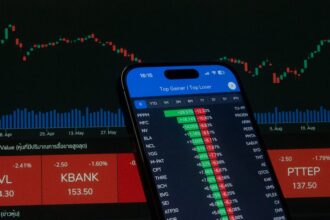Digital Nomad Money Hacks: Ultimate 2025 Guide to Managing Finances While Traveling
Master digital nomad finance in 2025. Learn banking, budgeting, tax strategies, & money hacks for managing finances while traveling the world.
Digital Nomad Money Hacks: How to Manage Finances While Traveling
The dream of working from a beach in Bali, a café in Lisbon, or a co-working space in Chiang Mai is more attainable than ever. With over 50 million digital nomads worldwide in 2025, the remote work revolution is in full swing . But beneath the Instagram-perfect sunsets lies a critical reality: financial stability is the bedrock of this lifestyle . Without a solid plan, the freedom of location independence can quickly turn into financial stress. This comprehensive guide dives deep into the essential **digital nomad money hacks** you need to master **managing finances while traveling** in 2025. We’ll cover everything from building a bulletproof budget and choosing the right banking tools to navigating complex international tax laws and securing your financial future. Whether you’re a seasoned road warrior or just starting your journey, these strategies will empower you to thrive financially, no matter where your laptop takes you.
Why Traditional Finance Fails Digital Nomads (And What to Do Instead)
The standard 9-to-5 financial playbook simply doesn’t translate to a life on the move. Digital nomads face unique challenges: fluctuating income streams, wildly varying costs of living across countries, complex international tax obligations, and the constant risk of unexpected expenses far from home . Relying on a single savings account or a domestic bank with hefty foreign transaction fees can drain your resources faster than you can say “currency conversion.” The first hack is a mindset shift: embrace flexibility and proactivity. Your financial strategy must be as dynamic as your itinerary. This means meticulously documenting your travels and expenses to establish tax residency or prove your nomadic status when needed . It also means accepting that income will likely be irregular, requiring robust systems to manage cash flow . Ignoring these realities is the fastest route to financial burnout. The alternative? A tailored, nomad-specific financial framework built for resilience and growth.
Building Your Digital Nomad Budget: The 3-Tier Framework
A realistic budget isn’t just a good idea; it’s your financial lifeline . The “3-Tier Budget Framework” is a proven strategy for 2025 . This approach categorizes your spending into essential, comfortable, and luxury tiers, allowing you to adapt quickly as your location or income changes.
Tier 1 – The Survival Essentials
This is your non-negotiable baseline, covering the absolute minimum needed to live and work. Calculate this meticulously for each potential destination.
* **Housing:** Research local costs. Options like coliving spaces, monthly Airbnb rentals, or long-term leases in less touristy areas can drastically reduce costs . In some countries, like Albania, you might find monthly expenses, including rent, averaging around $700 .
* **Food:** Prioritize local markets and cooking over eating out. Street food and local eateries are often delicious and incredibly affordable . Factor in a grocery budget.
* **Transportation:** Budget for local transit (buses, trains, scooters) and the occasional inter-city trip. Walking or cycling is often the cheapest and healthiest option .
* **Connectivity:** A reliable internet connection is your office. Factor in co-working space fees or the cost of a local SIM card with sufficient data .
* **Basic Health Insurance:** Never skip this. A basic international health plan is a Tier 1 expense .
Tier 2 – The Comfort Zone
This tier enhances your quality of life and productivity without breaking the bank.
* **Better Accommodation:** Upgrading to a place with a dedicated workspace or better amenities.
* **Dining Out:** Allowing for a few restaurant meals per week.
* **Local Experiences:** Budget for entry fees to museums, local tours, or weekend excursions.
* **Productivity Tools:** Subscriptions to essential software (project management, cloud storage, VPN).
* **Enhanced Insurance:** Adding coverage for adventure sports or higher medical limits.
Tier 3 – The Luxury Layer
This is for discretionary spending when your income allows.
* **Fancy Restaurants & Bars**
* **International Flights for Vacations**
* **Premium Co-working Spaces or Retreats**
* **High-End Gear or Gadgets**
* **Spa Treatments or Extensive Tours**
The power of this framework is its adaptability. If a client payment is delayed, you can temporarily scale back to Tier 1. When you land a big project, you can enjoy Tier 3 guilt-free. Always pad your budget with a buffer for unexpected local price hikes or travel costs .
Banking Like a Pro: Choosing the Right Financial Tools for 2025
Your choice of bank can make or break your financial efficiency. Traditional banks often charge exorbitant fees for international transactions and ATM withdrawals, which can add up to 3-5% or more per transaction . This is unacceptable for a global citizen. The solution lies in specialized digital banking solutions designed for nomads.
The Must-Have Features for Nomad Banking
* **Zero Foreign Transaction Fees:** This is non-negotiable. Every purchase in a foreign currency should be at the real exchange rate.
* **Global ATM Fee Reimbursement:** Avoid being charged by both your bank and the ATM operator. Some accounts, like Charles Schwab, offer unlimited worldwide ATM fee reimbursements .
* **Multi-Currency Accounts:** Hold, send, and receive money in multiple currencies (USD, EUR, GBP, etc.) to avoid constant conversion fees and hedge against currency fluctuations .
* **User-Friendly App:** Manage everything seamlessly from your phone, including instant currency exchange.
* **Low or No Monthly Fees:** Keep your overhead minimal.
Top Banking Contenders for Digital Nomads in 2025
Based on current offerings, here are some leading options:
* **Revolut:** Praised for eliminating foreign transaction fees and offering multi-currency accounts, making it a favorite for spending abroad . It also functions as a combined banking and budgeting app .
* **Wise (formerly TransferWise):** Renowned for its transparent, mid-market exchange rates and low-cost international transfers. Excellent for receiving payments from clients worldwide .
* **Charles Schwab Bank:** A strong choice for U.S.-based nomads, offering no foreign transaction fees and ATM fee reimbursements globally .
* **N26 & Monzo:** Popular European neobanks with strong international features and user-friendly interfaces .
* **Bunq:** Another European option known for its flexibility and travel-friendly features .
The key is to research and potentially use a combination. For instance, you might use Wise to receive client payments in USD and then transfer funds to your Revolut account for daily spending in local currencies.
Mastering Money Movements: Currency Exchange and Fee Avoidance
Beyond choosing the right bank, actively managing currency exchange is a crucial money hack. Banks and airport kiosks often offer poor exchange rates with hidden markups of 3-5% . Here’s how to fight back:
* **Use Your Nomad Bank Card for Purchases:** When paying with your Revolut, Wise, or Schwab card, you typically get the real interbank exchange rate, saving you significant money compared to exchanging cash .
* **Avoid Dynamic Currency Conversion (DCC):** When paying by card abroad, the merchant might ask if you want to pay in your home currency. Always choose to pay in the *local* currency. DCC uses a poor exchange rate set by the merchant’s bank.
* **Withdraw Larger Amounts Less Frequently:** While ATM fees might be reimbursed, minimizing the number of transactions reduces hassle and potential for errors.
* **Compare Rates for Large Transfers:** For significant sums, use dedicated currency transfer services like Currencies Direct, which often offer better rates and zero transfer fees compared to banks .
* **Monitor Exchange Rates:** Use apps like Xe Currency to track rates and exchange money when it’s favorable, especially if you’re moving between countries with different currencies frequently .
By being vigilant, you can save hundreds, if not thousands, of dollars annually.
The Emergency Fund: Your Financial Safety Net on the Road
Perhaps the most critical **digital nomad money hack** is building a robust emergency fund. Life on the road is unpredictable. A laptop could break, a medical emergency could arise, or a client might ghost you. Without a safety net, a minor crisis can become a major disaster, forcing you to cut your trip short or take on high-interest debt.
How Much Do You Really Need?
The standard advice of 3-6 months of living expenses holds true, but for digital nomads, it’s often wise to lean towards the higher end . Given the potential for higher travel-related costs (like an emergency flight home), some experts recommend saving enough to cover 1-3 months of *all* expenses, including a contingency flight . This fund should be kept separate from your everyday spending account, in a high-interest savings account or a liquid, easily accessible part of your nomad bank account .
Building Your Fund
* **Start Small, Start Now:** Even saving $50 a week adds up. Automate transfers to your emergency fund as soon as you receive income.
* **Treat It as a Non-Negotiable Expense:** Include it as a line item in your Tier 1 budget.
* **Use Windfalls Wisely:** Allocate bonuses, tax refunds, or unexpected income directly to your emergency fund.
* **Replenish After Use:** If you dip into it, prioritize rebuilding it as quickly as possible.
This fund isn’t just about money; it’s about peace of mind. It allows you to handle slow months or unexpected costs without derailing your entire journey .
Tax Tango: Navigating International Tax Laws in 2025
Taxes are arguably the most complex aspect of **managing finances while traveling**. The myth that you can simply avoid taxes by moving around is dangerous and untrue. Most countries determine tax residency based on physical presence, often using the 183-day rule (spending more than half the year in a country) . You may have tax obligations in your home country, your host country, or both.
Key Strategies for U.S. Digital Nomads
American nomads face unique challenges as the U.S. taxes its citizens on worldwide income.
* **Foreign Earned Income Exclusion (FEIE):** This is a major benefit. For 2025, you can exclude up to $130,000 of foreign-earned income from U.S. taxation . To qualify, you must pass either the Bona Fide Residence Test or the Physical Presence Test (330 full days in a foreign country during a 12-month period).
* **Foreign Tax Credit (FTC):** If you pay income tax to a foreign government, you can often claim a credit on your U.S. return to avoid double taxation .
* **Foreign Housing Exclusion/Deduction:** You may be able to exclude or deduct certain housing expenses paid with foreign-earned income .
* **FBAR & FATCA Reporting:** If you have over $10,000 in aggregate in foreign bank accounts at any time during the year, you must file an FBAR (FinCEN Form 114). FATCA reporting may also be required for certain foreign assets.
Strategies for Non-U.S. Nomads
* **Understand Your Home Country’s Exit Rules:** Some countries require you to formally cease tax residency, which may involve filing final returns or paying exit taxes .
* **Research Host Country Tax Laws:** Before settling in a country for an extended period, understand its tax residency rules and rates. Some countries, like Portugal, offer special tax regimes for new residents .
* **Leverage Tax Treaties:** Many countries have double taxation agreements (DTAs) to prevent the same income from being taxed twice . Understand how these treaties apply to you.
* **Consider Tax-Efficient Locations:** Some countries have territorial tax systems (taxing only locally sourced income) or very low/zero income tax rates, which can be attractive for nomads .
The Golden Rule: Consult a Professional
Tax laws are complex and constantly changing. The best money hack here is to invest in a qualified accountant or tax advisor who specializes in expat or digital nomad taxation. A few hundred dollars spent on advice can save you thousands in penalties and optimize your tax burden. Meticulously document your travels, as this digital footprint can be crucial for proving your residency status .
Insurance: Protecting Your Health and Assets Abroad
Relying on your domestic health insurance while abroad is a massive risk. Most standard plans offer little to no coverage internationally. Comprehensive insurance is not an optional extra; it’s a core component of your financial safety net.
Health Insurance vs. Travel Insurance
It’s crucial to understand the difference .
* **Travel Insurance:** Typically covers trip cancellations, lost luggage, and *emergency* medical treatment for accidents or sudden illness during a specific trip. It’s often short-term.
* **International Health Insurance:** Designed for long-term travelers and expats, providing comprehensive coverage for ongoing medical care, hospitalization, and sometimes even routine check-ups and dental work. This is what digital nomads need.
Top Insurance Providers for Digital Nomads in 2025
* **SafetyWing:** Frequently cited as the best option for digital nomads, offering flexible monthly subscription plans (starting around $45/month) that cover medical emergencies and even some travel-related issues . It’s designed for the nomadic lifestyle .
* **World Nomads:** Another popular choice, known for covering adventure activities.
* **IMG Global (Patriot America Lite, Global Medical Insurance):** Offers a range of plans suitable for long-term travelers .
* **Heymondo:** Their Long Trip Plan is noted as a good option for nomads, costing about $47 per month (prices increase if including U.S. travel) .
When choosing a plan, consider your age, health, planned activities, and destinations. Ensure it covers medical evacuation, as this can be astronomically expensive. Don’t forget about travel insurance for specific trips to cover non-medical issues like flight delays or lost baggage.
Creating Financial Stability: Diversifying Income and Building Passive Streams
Relying on a single client or income source is risky. The most financially secure digital nomads diversify their revenue streams . This provides a buffer during slow periods and accelerates wealth building.
Active Income Diversification
* **Multiple Clients:** If you’re a freelancer, aim to have 3-5 steady clients rather than one large one.
* **Different Service Offerings:** Expand your skillset. A writer could also offer editing or social media management.
* **Retainers:** Secure monthly retainers for ongoing work, providing predictable cash flow.
Building Passive Income (The Ultimate Money Hack)
Passive income is the holy grail, generating revenue with minimal ongoing effort. While it often takes time to build, it’s essential for long-term nomadic freedom .
* **Digital Products:** Create and sell ebooks, online courses, templates, or stock photography . This is often the easiest entry point .
* **Affiliate Marketing:** Earn commissions by promoting products or services you believe in via your blog, social media, or YouTube channel .
* **Dropshipping or Print-on-Demand:** Set up an online store without holding inventory .
* **Dividend-Paying Stocks and ETFs:** Invest in the stock market for regular payouts . This requires capital but is a classic wealth-building strategy.
* **Rental Income:** While more complex, investing in property (even remotely, like UK property) can provide steady income .
Many nomads start small, aiming for passive streams that cover extras ($200–500/month) before scaling up . Reinvesting income back into your business or passive income ventures is a common strategy for long-term growth .
Long-Term Vision: Retirement and Investment Planning on the Go
Just because you’re not living in a traditional home doesn’t mean you should neglect your future. **Managing finances while traveling** includes planning for retirement and building long-term wealth.
H2: The Unique Challenges
Nomadic retirement involves navigating fluctuating income, variable living costs, foreign healthcare systems in later life, and complex international tax laws . Traditional retirement accounts (like a 401k or IRA for Americans) may have restrictions or tax implications when accessed from abroad.
Strategies for 2025
* **Continue Contributing (If Possible):** If you’re eligible and it makes tax sense, continue contributing to your home country’s retirement accounts. For U.S. citizens, contributing to an IRA while claiming the FEIE can be complex; consult a tax advisor.
* **Global Investment Accounts:** Look into international brokerage accounts that allow you to invest in global index funds or ETFs, providing diversification.
* **Real Estate Investment:** As mentioned, property can be a long-term, hands-off income source .
* **Build a “Freedom Fund”:** Instead of a traditional retirement account, focus on building a large, diversified investment portfolio that generates enough passive income to cover your desired lifestyle anywhere in the world. This is the essence of “financial freedom” for many nomads .
* **Plan for Healthcare in Retirement:** Research international health insurance options for older adults or consider countries with affordable, high-quality public healthcare systems for retirees.
The key is to start early and be consistent, even if contributions are small. The power of compound interest works just as well for nomads as it does for anyone else.
Case Studies: Real-World Digital Nomad Finance Success Stories
* **Case Study 1: Maria, the Freelance Designer**
Maria, a graphic designer from Canada, transitioned to full-time nomadism in 2023. Her initial mistake was using her Canadian bank, which charged her 2.5% on every transaction and $5 per ATM withdrawal. After six months, she switched to a combination of Wise (for receiving client payments in USD and EUR) and Revolut (for daily spending). This saved her over $1,200 in her first year. She also implemented the 3-Tier Budget, allowing her to live comfortably in Portugal (Tier 2) while saving for a trip to Japan (Tier 3). She started a small passive income stream by selling Canva templates on Etsy, which now brings in about $300/month, covering her health insurance premiums.
* **Case Study 2: David and Lena, the Remote Couple**
This American couple runs a small online marketing agency. They meticulously track their expenses using the Spendee app, which is designed for travelers and handles multiple currencies . They qualify for the U.S. Foreign Earned Income Exclusion by spending over 330 days a year outside the U.S. They’ve built a 6-month emergency fund, which they used when a client unexpectedly went bankrupt. They’ve also started investing 15% of their income into a globally diversified ETF portfolio through an international brokerage, focusing on long-term wealth for a potential “semi-retirement” in a low-cost country like Vietnam, which tops lists for affordability .
These stories highlight that success comes from applying the core **digital nomad money hacks**: smart banking, rigorous budgeting, tax optimization, and forward-thinking investment.
Cost of Living Showdown: Where to Stretch Your Dollar in 2025
Geoarbitrage—earning in a strong currency while living in a country with a lower cost of living—is a fundamental hack for maximizing your income. Here’s a look at some top affordable destinations for 2025 based on recent data:
* **Vietnam:** Consistently ranked as one of the most affordable, with a vibrant nomad community, fast internet, and delicious food. Monthly costs can range from $600-$1300 .
* **Indonesia (Bali):** A perennial favorite. While parts of Bali are becoming more expensive, areas outside the main tourist hubs offer great value. Strong community and infrastructure .
* **Thailand:** Offers a fantastic balance of low cost, excellent infrastructure, and diverse experiences (beaches, mountains, cities). A top choice for many .
* **Mexico:** Proximity to the U.S. makes it attractive for North Americans. Offers diverse landscapes and a relatively low cost of living, especially outside major cities like Mexico City .
* **Portugal:** For those seeking Europe, Portugal remains one of the most affordable Western European countries, with a high quality of life, good internet, and welcoming digital nomad visa programs . Average monthly costs for nomads are around €520 in some areas .
* **Colombia & Georgia:** Both offer very low living costs and are gaining popularity among nomads .
Always research specific cities within these countries, as costs can vary dramatically. Use online cost-of-living calculators and nomad forums to get the most current data before you go.
Your 2025 Digital Nomad Financial Toolkit
Equipping yourself with the right apps and tools is half the battle. Here’s a curated list for 2025:
* **Budgeting & Expense Tracking:**
* **Spendee:** Excellent for nomads, handles multiple currencies .
* **Mint:** Connects to bank accounts to track spending and create budgets .
* **Trail Wallet (or similar):** Simple app to track daily expenses on the go .
* **Banking & Payments:**
* **Revolut, Wise, Charles Schwab:** As discussed for banking .
* **PayPal, Stripe:** For receiving client payments.
* **Currency Conversion:**
* **XE Currency:** Real-time exchange rates .
* **Taxes:**
* **QuickBooks Self-Employed:** Helps track income and expenses for tax time .
* **Receipt Scanning Apps:** Keep digital copies of all receipts for tax purposes.
* **Productivity (Indirectly Impacts Income):**
* **Project Management (Trello, Asana, Notion):** Stay organized and billable .
* **Time Tracking (Toggl, Clockify):** Essential for freelancers to ensure accurate billing.
* **Cloud Storage (Google Drive, Dropbox):** Securely store financial documents .
The best toolkit is the one you’ll actually use consistently. Start with one or two apps and build from there.
Mastering Your Money, Mastering Your Freedom
**Managing finances while traveling** is not about deprivation; it’s about empowerment. By implementing these **digital nomad money hacks**, you transform financial anxiety into confident freedom. From setting up a smart 3-Tier Budget and choosing fee-free banking to navigating the complexities of international taxes and building a robust emergency fund, each step solidifies your ability to thrive on the road. Remember, the goal is sustainability. Diversify your income, explore passive revenue streams, and never neglect long-term planning, even if “retirement” looks different for you. The world is your office, but only if your finances are in order. Start applying these strategies today, consult professionals when needed, and take control of your financial destiny. Your next adventure—and your financial security—depends on it. What’s the first money hack you’ll implement on your journey?
FAQ: Digital Nomad Money Hacks 2025
1. What is the single most important financial tip for a new digital nomad?
**Answer:** Build a 3-6 month emergency fund *before* you leave . This is your absolute safety net for unexpected expenses, medical emergencies, or income gaps. Without it, a minor setback can force you to abandon your journey. Keep it in a separate, easily accessible account .
2. Do I really need to pay taxes if I’m constantly moving and not living in one country?
**Answer:** Yes, almost certainly. Your tax obligations are typically tied to your citizenship (e.g., U.S. citizens) or your tax residency, which is often determined by how many days you spend in a country (e.g., the 183-day rule) . You may need to file in your home country and potentially in countries where you’ve spent significant time. Ignoring this can lead to severe penalties. Always consult a tax professional specializing in expat/nomad taxes .
3. Which bank or financial service is best for avoiding international fees in 2025?
**Answer:** There’s no single “best,” as it depends on your home country and travel patterns. However, top contenders known for low or no foreign fees include **Revolut** (great for spending), **Wise** (excellent for receiving international payments), and **Charles Schwab** (ideal for U.S. citizens due to ATM fee reimbursements) . Look for accounts with zero foreign transaction fees and multi-currency capabilities .
4. How much passive income do I need to become a full-time digital nomad?
**Answer:** There’s no fixed amount; it depends entirely on your desired lifestyle and cost of living. Many nomads start by building small streams that cover specific expenses (e.g., $200-$500/month for insurance or food) . To fully replace an active income, you’ll likely need a significant portfolio. A common goal is to generate enough passive income to cover your Tier 1 and Tier 2 budget in your chosen destinations. It usually takes years of consistent effort to build substantial passive income .
5. Is travel insurance enough, or do I need international health insurance?
**Answer:** For long-term digital nomadism, **international health insurance** is essential. Travel insurance typically only covers emergencies and short trips . Health insurance provides comprehensive coverage for ongoing medical needs, hospitalization, and sometimes preventative care, which is crucial when you’re living abroad for months or years. Providers like **SafetyWing** are specifically designed for this lifestyle . Don’t risk your health and finances by being underinsured.








